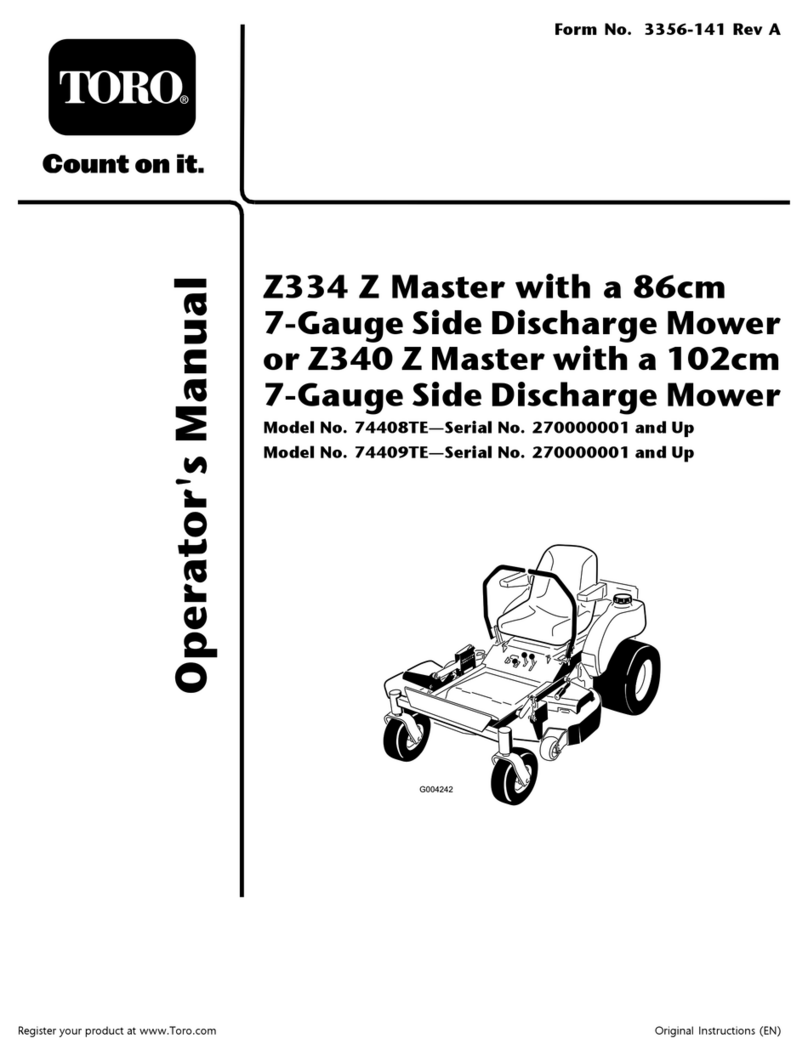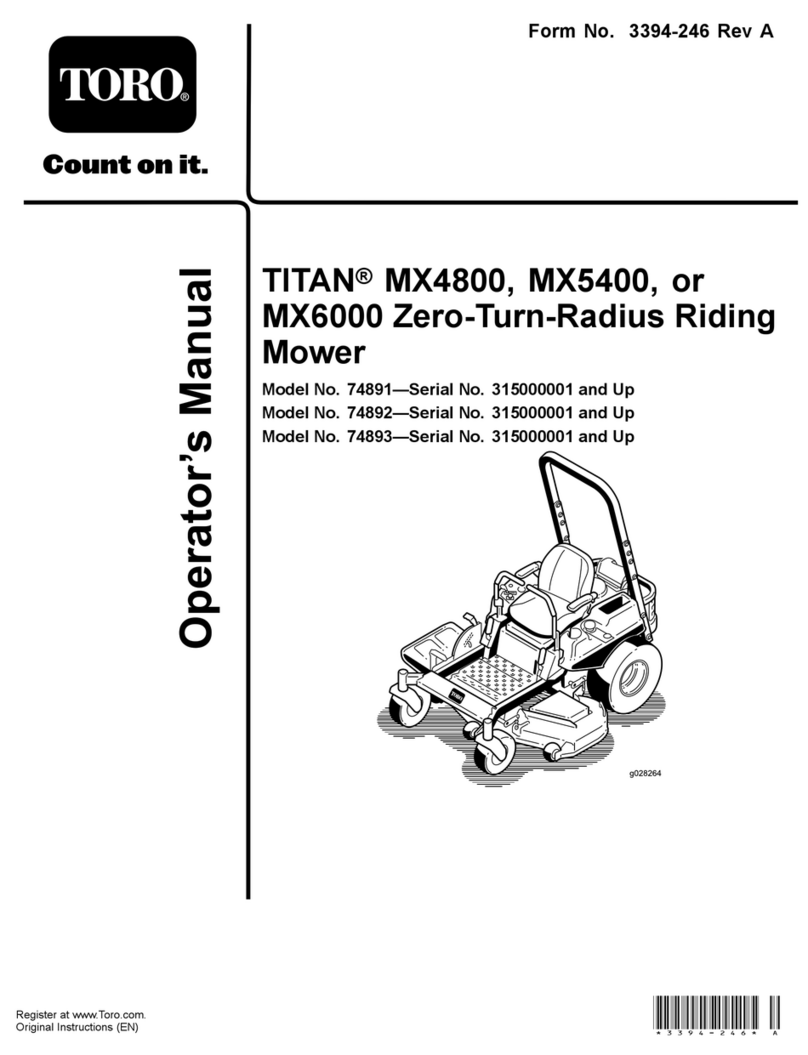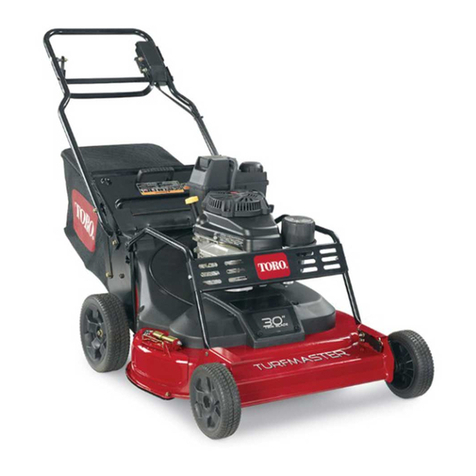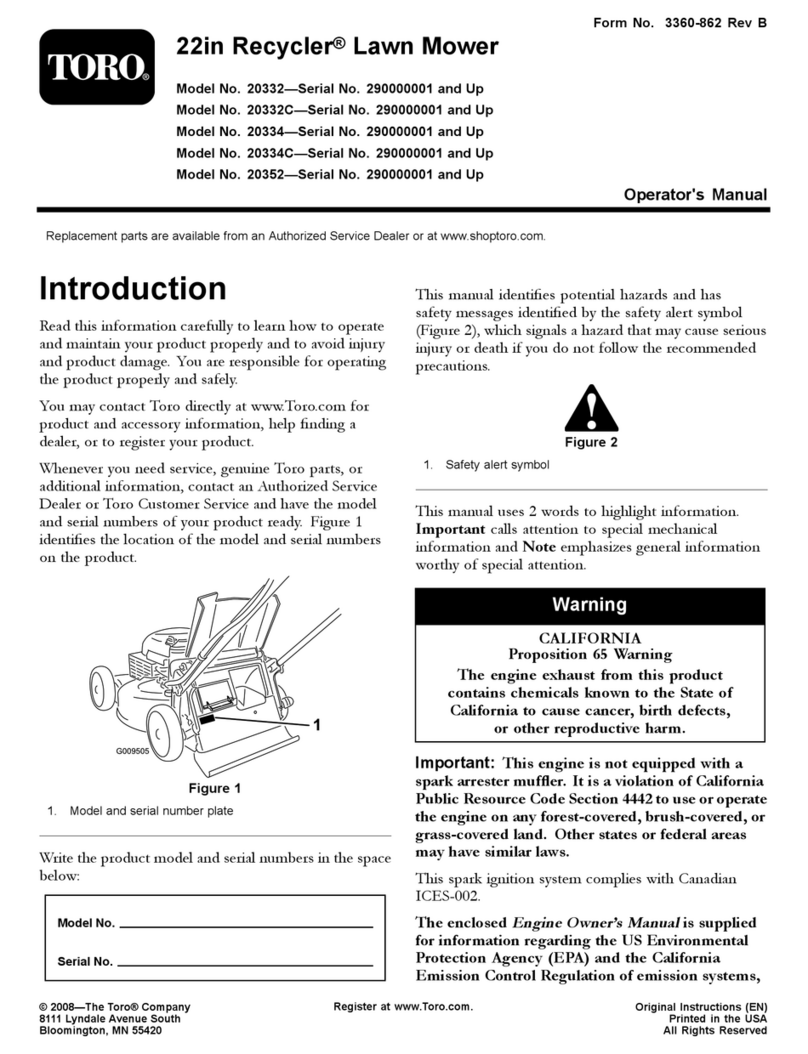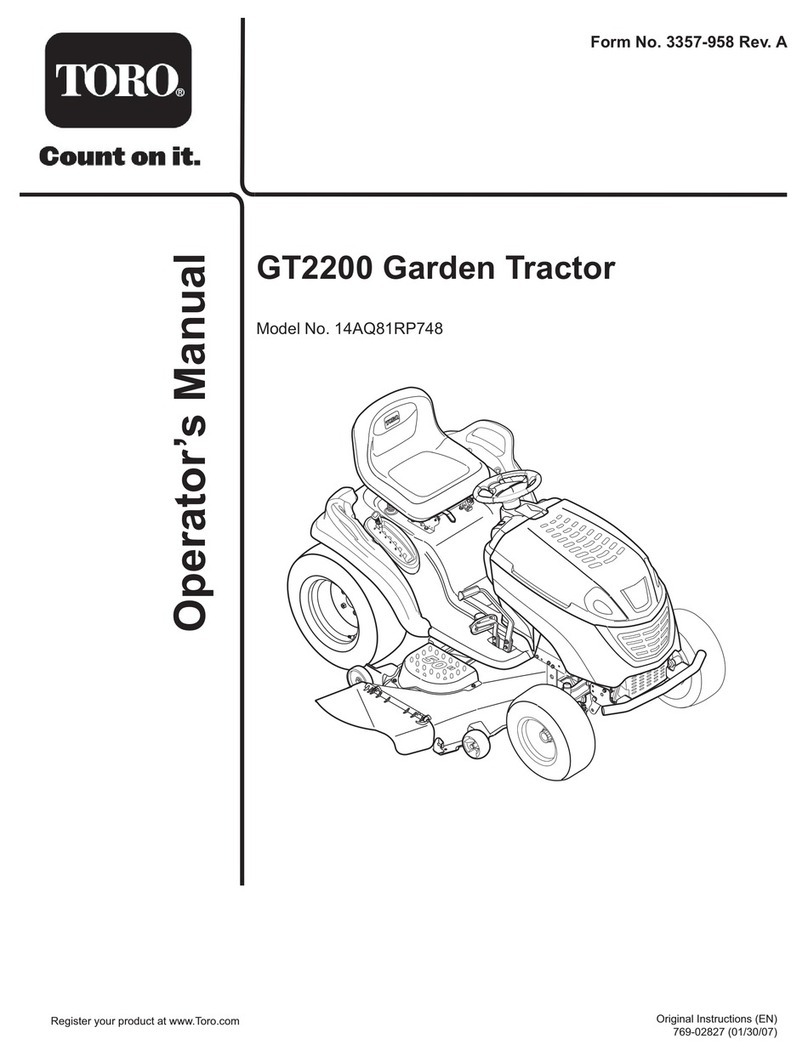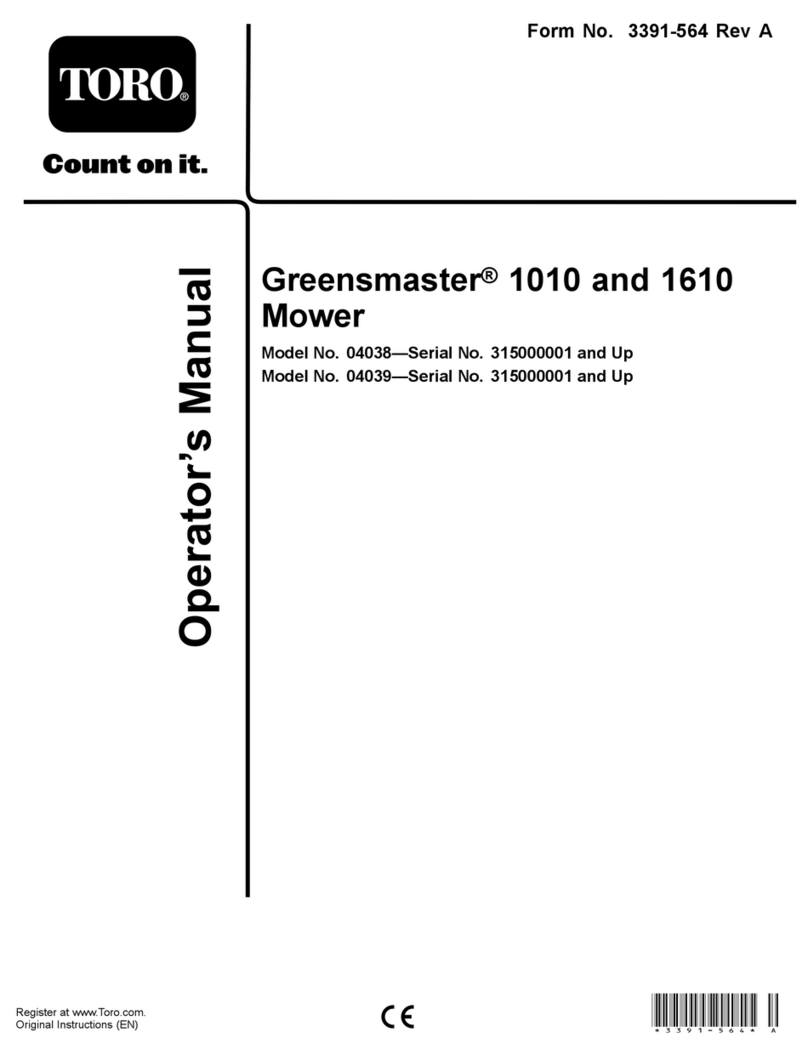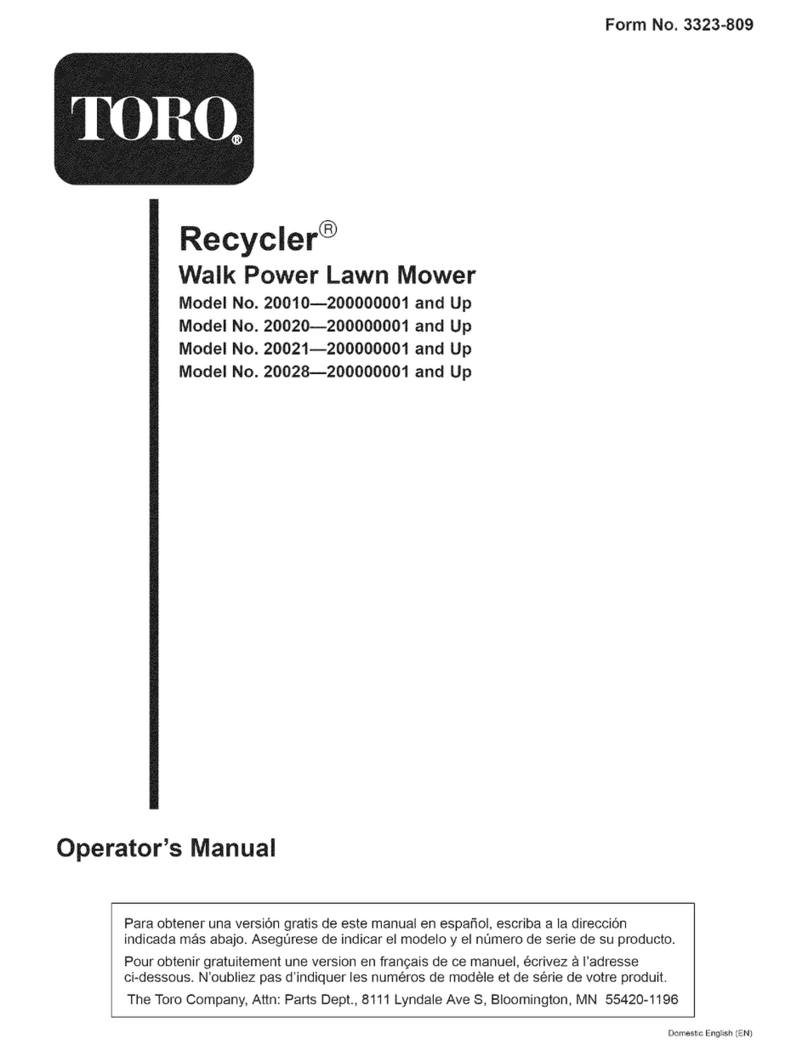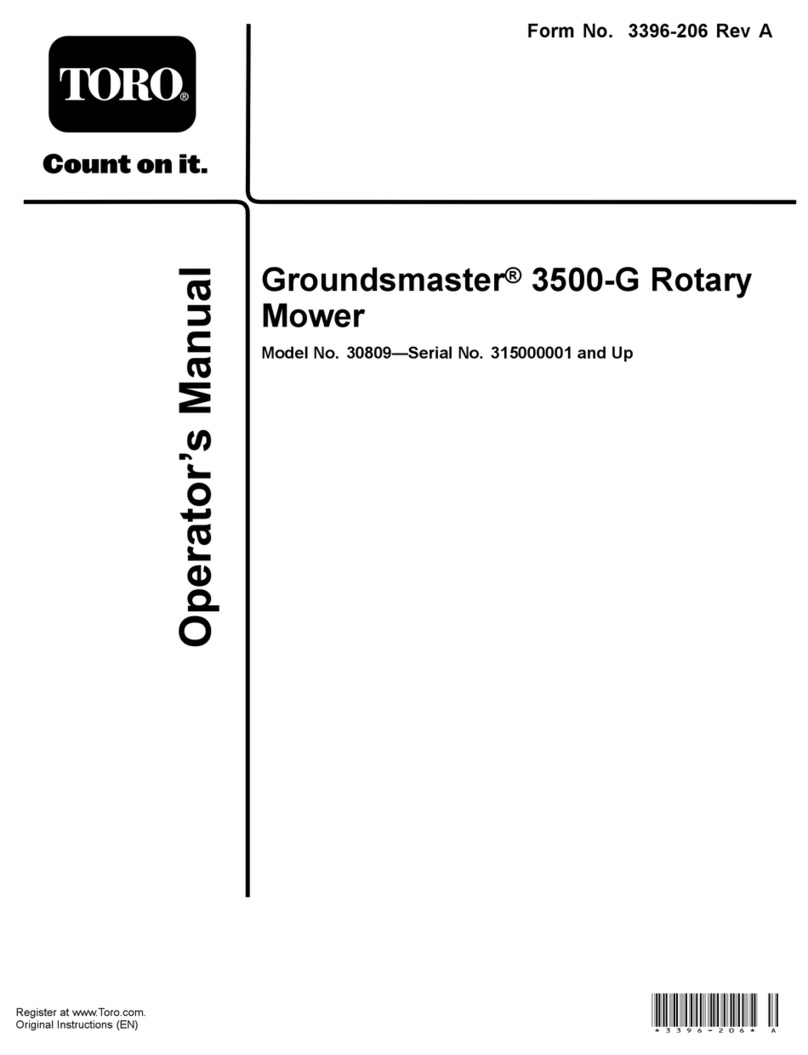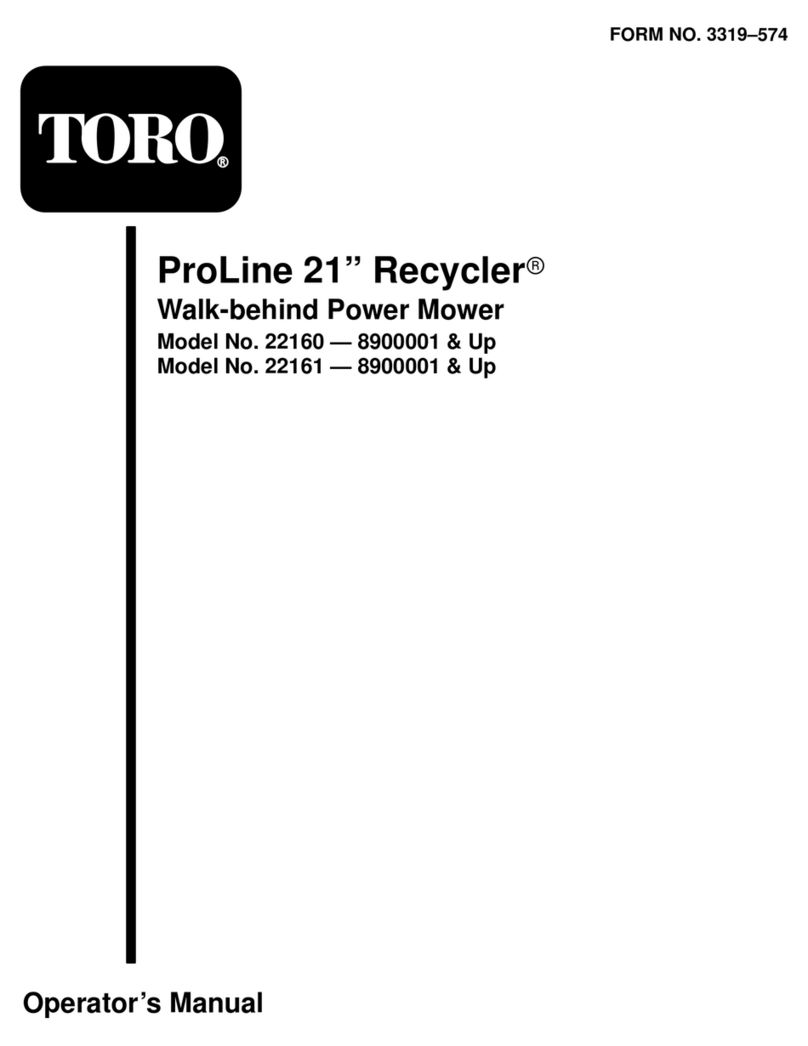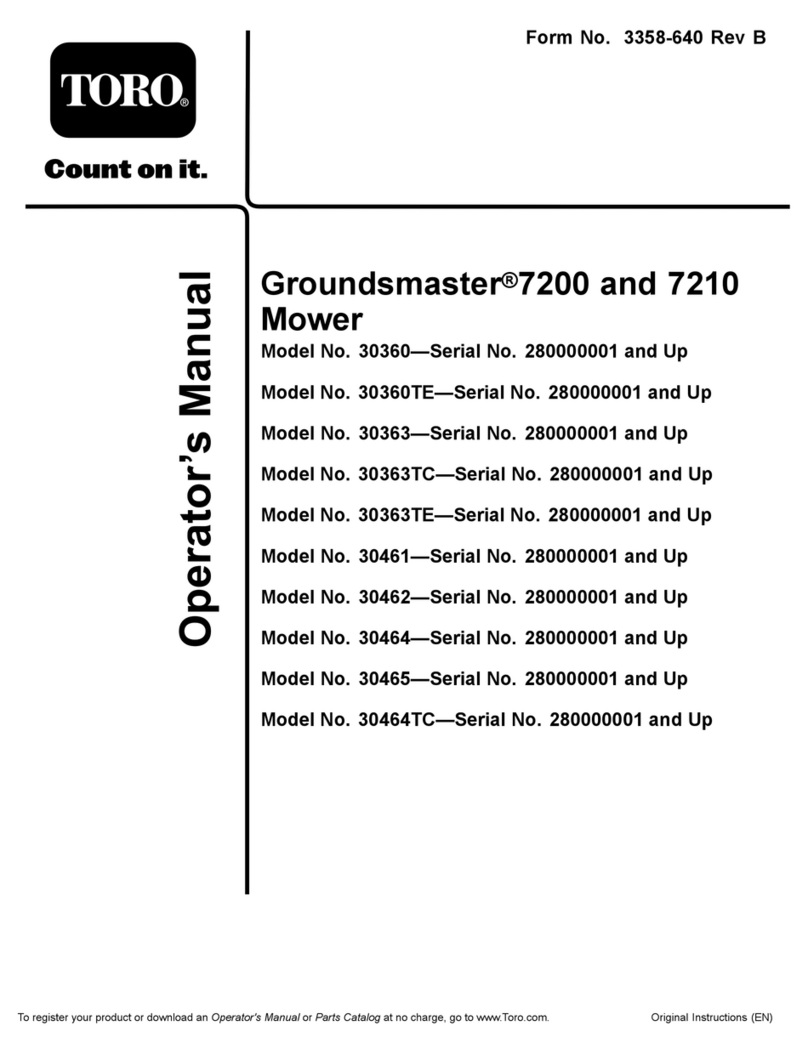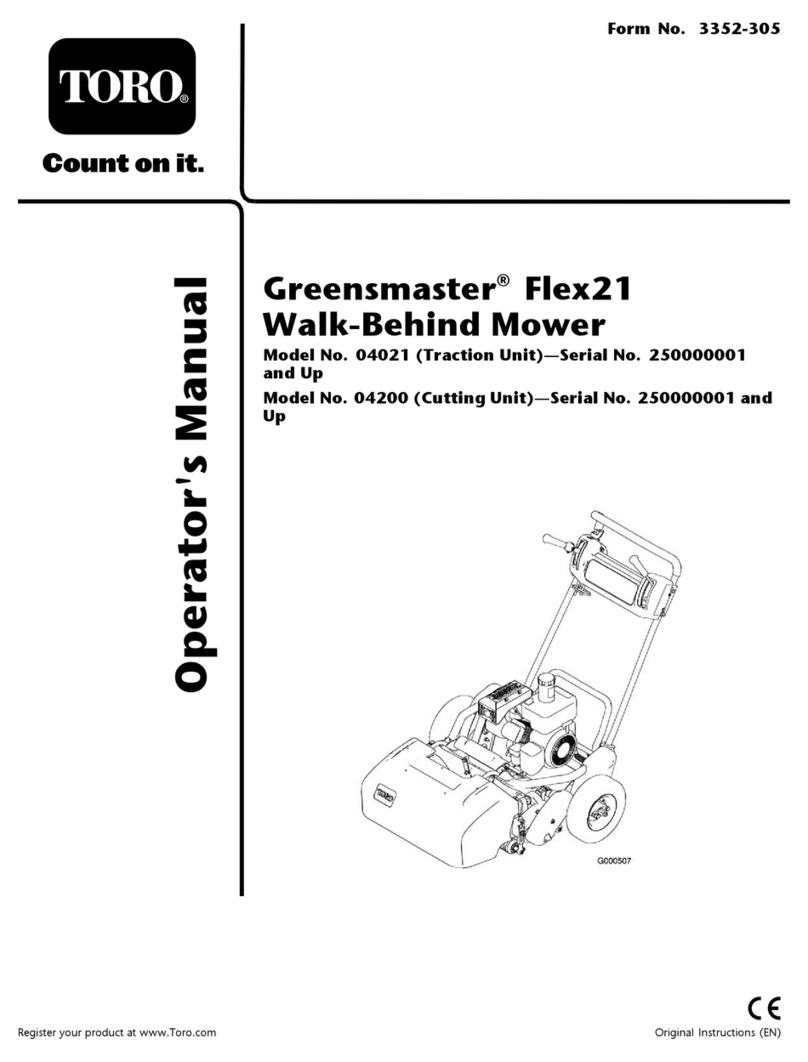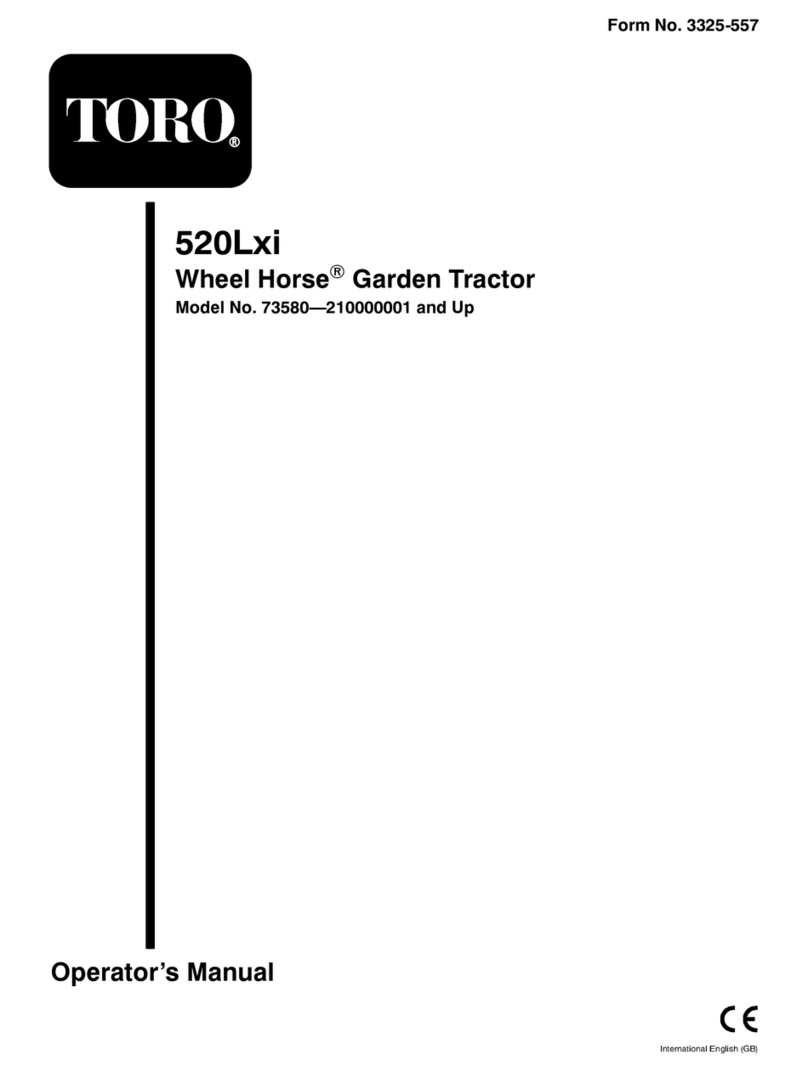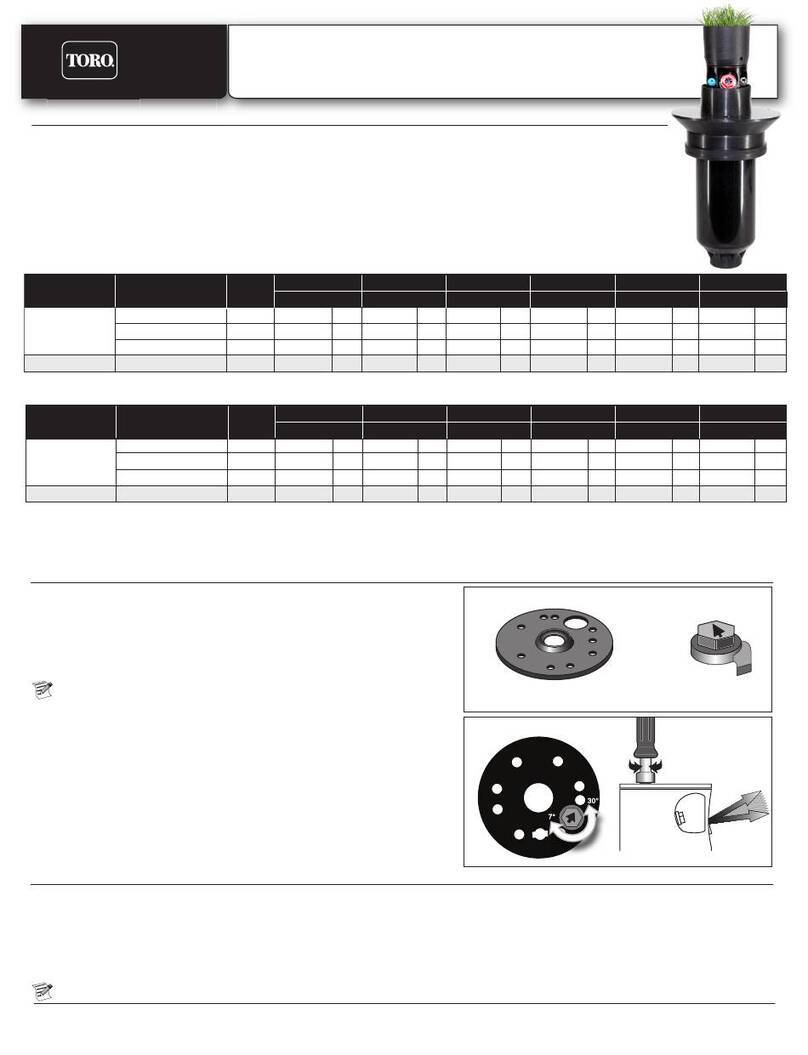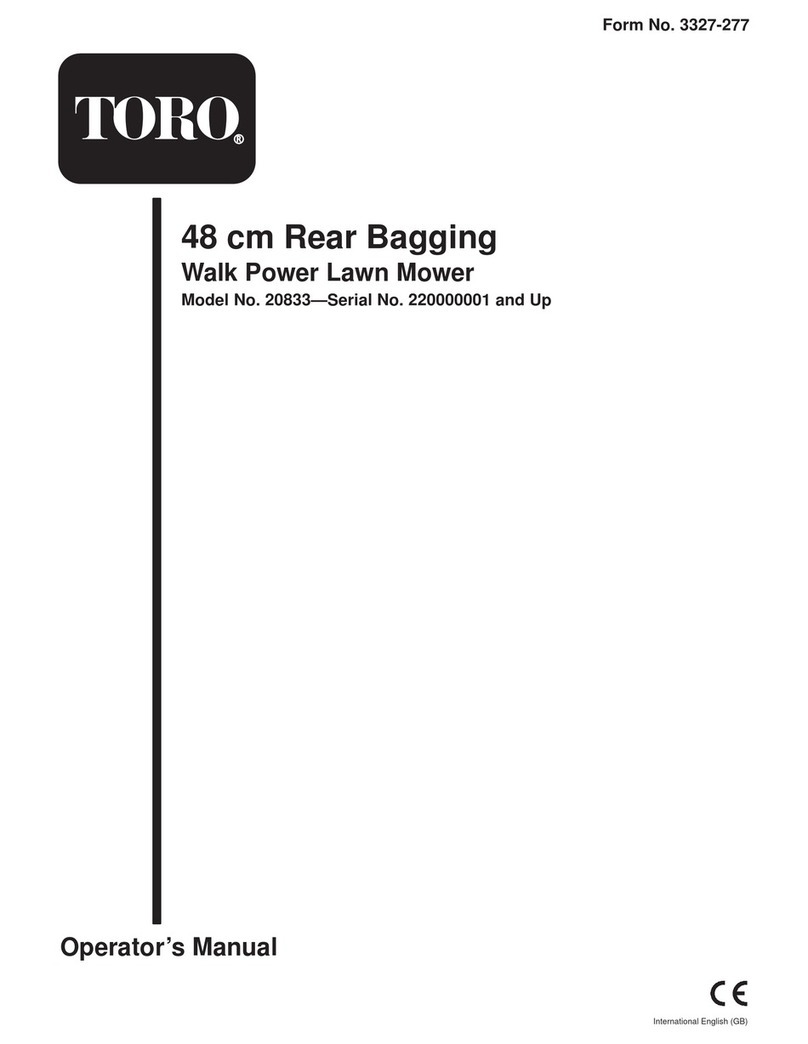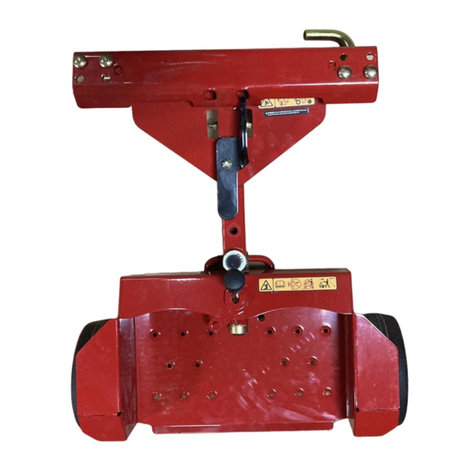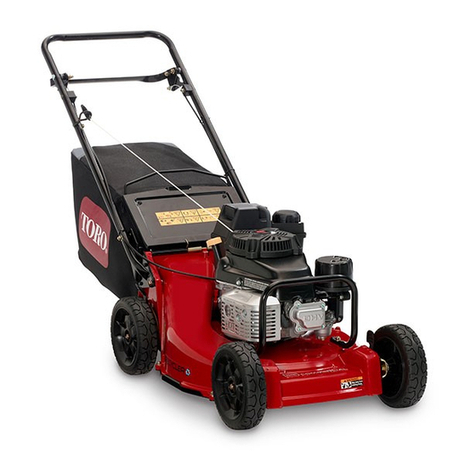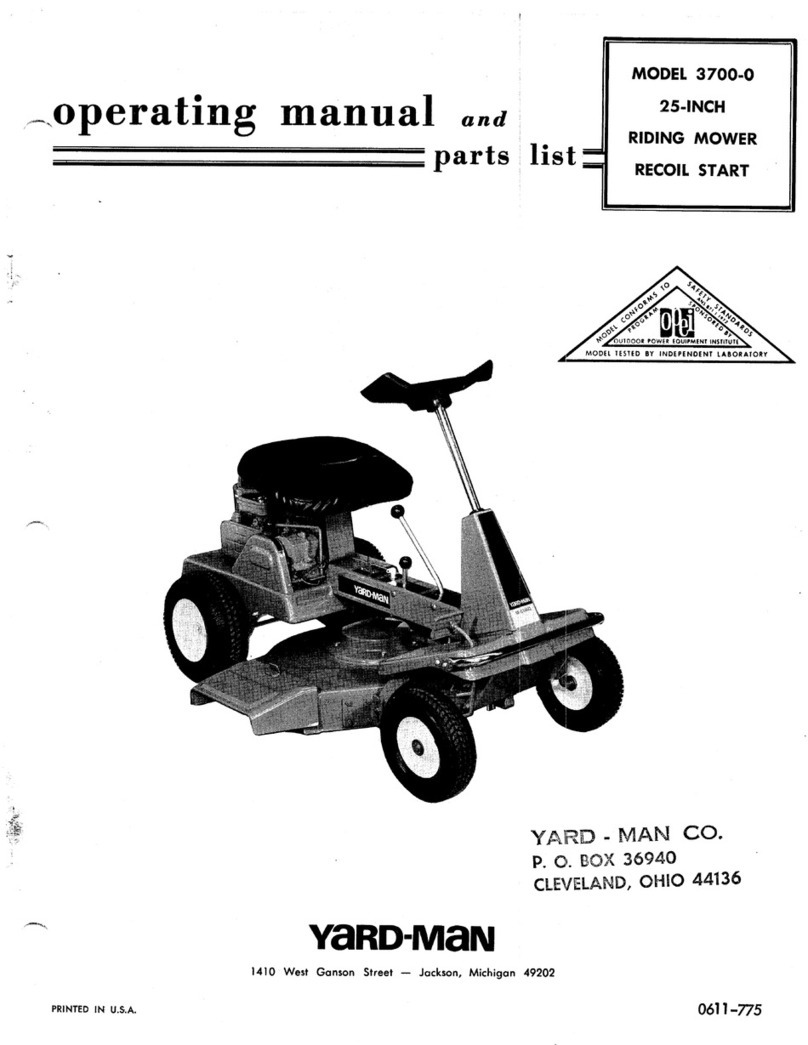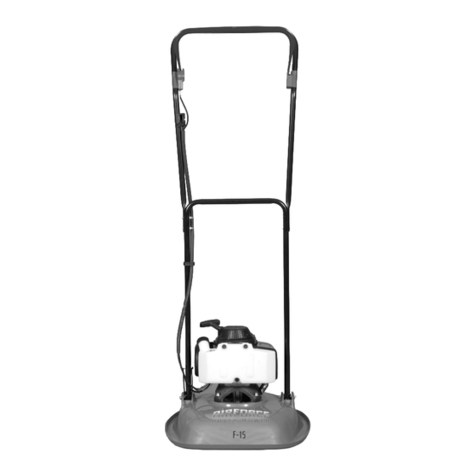
2
All Rights Reserved
Printed in the USA
W2008 by The Toro Company
8111 Lyndale Avenue South
Bloomington, MN 55420-1196
The engine exhaust from this product contains
chemicals known to the State of California to cause
cancer, birth defects, or other reproductive harm.
Warning
Important The engine in this product is not equipped
with a spark arrester muffler. It is a violation of California
Public Resource Code Section 4442 to use or operate this
engine on any forest-covered, brush-covered, or
grass-covered land as defined in CPRC 4126. Other states
or federal areas may have similar laws.
Contents
Page
Introduction 3. . . . . . . . . . . . . . . . . . . . . . . . . . . . . . . .
Safety 3. . . . . . . . . . . . . . . . . . . . . . . . . . . . . . . . . . . . .
Safe Operating Practices 4. . . . . . . . . . . . . . . . . . . .
Toro Riding Mower Safety 6. . . . . . . . . . . . . . . . . .
Sound Power Level 7. . . . . . . . . . . . . . . . . . . . . . .
Sound Pressure Level 7. . . . . . . . . . . . . . . . . . . . . .
Vibration Level 7. . . . . . . . . . . . . . . . . . . . . . . . . . .
Safety and Instruction Decals 7. . . . . . . . . . . . . . . .
Specifications 13. . . . . . . . . . . . . . . . . . . . . . . . . . . . . . .
General Specifications 13. . . . . . . . . . . . . . . . . . . . .
Dimensions and Weights (approx.) 14. . . . . . . . . . .
Attachments/Accessories 14. . . . . . . . . . . . . . . . . . .
Setup 15. . . . . . . . . . . . . . . . . . . . . . . . . . . . . . . . . . . . .
Loose Parts 15. . . . . . . . . . . . . . . . . . . . . . . . . . . . . .
Installing the Steering Cylinder
(Models 30627 & 30631 only) 16. . . . . . . . . . . . .
Installing the Tie Rod
(Models 30627 & 30631 only) 16. . . . . . . . . . . . .
Installing the Rear Bumper
(Models 30627 & 30631 only) 16. . . . . . . . . . . . .
Installing the Front and Rear Wheels 16. . . . . . . . . .
Removing the Battery from the Chassis 16. . . . . . . .
Installing the Seat 17. . . . . . . . . . . . . . . . . . . . . . . . .
Installing the Seat Belt 18. . . . . . . . . . . . . . . . . . . . .
Installing the Roll Bar 19. . . . . . . . . . . . . . . . . . . . .
Pushing the Traction Unit Off of the Pallet 19. . . . .
Activating and Charging the Battery 19. . . . . . . . . .
Installing the Battery in the Chassis 20. . . . . . . . . . .
Installing the Ball Joint and Connecting the Lift
Cylinder 21. . . . . . . . . . . . . . . . . . . . . . . . . . . . . . .
Checking the Tire Pressure 21. . . . . . . . . . . . . . . . . .
Checking the Torque of the Front Wheel Nuts 22. . .
Greasing the Traction Unit 22. . . . . . . . . . . . . . . . . .
Install Rear Weight 22. . . . . . . . . . . . . . . . . . . . . . . .
Before Operating 23. . . . . . . . . . . . . . . . . . . . . . . . . . . .
Hood Prop
(Models 30626 & 30627 only) 23. . . . . . . . . . . . .
Checking the Crankcase Oil 23. . . . . . . . . . . . . . . . .
Filling the Fuel Tank 24. . . . . . . . . . . . . . . . . . . . . .
Check Cooling System 24. . . . . . . . . . . . . . . . . . . . .
Checking the Hydraulic System Fluid 25. . . . . . . . .
Checking the Hydraulic System 25. . . . . . . . . . . . . .
Checking the Rear Axle 26. . . . . . . . . . . . . . . . . . . .
Check Bidirectional Clutch Lubricant
(Models 30627 & 30631 only) 26. . . . . . . . . . . . .
Operation 27. . . . . . . . . . . . . . . . . . . . . . . . . . . . . . . . . .
Controls 27. . . . . . . . . . . . . . . . . . . . . . . . . . . . . . . .
Starting/Stopping Engine 29. . . . . . . . . . . . . . . . . . .
Bleeding Fuel System 29. . . . . . . . . . . . . . . . . . . . . .
Checking the Interlock Switches 30. . . . . . . . . . . . .
Pushing or Towing the Traction Unit 30. . . . . . . . . .
Operating Characteristics 31. . . . . . . . . . . . . . . . . . .
Maintenance 32. . . . . . . . . . . . . . . . . . . . . . . . . . . . . . . .
Recommended Maintenance Schedule 32. . . . . . . . .
Daily Maintenance Checklist 33. . . . . . . . . . . . . . . .
Lubricating the Machine 34. . . . . . . . . . . . . . . . . . .
General Air Cleaner Maintenance 35. . . . . . . . . . . .
Servicing Air Cleaner 35. . . . . . . . . . . . . . . . . . . . . .
Cleaning the Radiator and Screen 36. . . . . . . . . . . .
Changing Engine Oil And Filter 36. . . . . . . . . . . . . .
Servicing Fuel System 37. . . . . . . . . . . . . . . . . . . . .
Bleeding Air From Injectors 38. . . . . . . . . . . . . . . . .
Cleaning Radiator And Screen 38. . . . . . . . . . . . . . .
Changing Coolant In Cooling System 38. . . . . . . . .
Servicing the Engine Belts 39. . . . . . . . . . . . . . . . . .
Adjusting Throttle 40. . . . . . . . . . . . . . . . . . . . . . . .
Adjusting Traction Control Rod 40. . . . . . . . . . . . . .
Adjusting Traction Pedal Friction Wheel 41. . . . . . .
Adjusting the Traction Drive for Neutral 41. . . . . . .
Adjusting the Traction Interlock Switch 41. . . . . . . .
Replacing the PTO Switch 41. . . . . . . . . . . . . . . . . .
Adjusting PTO Drive Belt Tension 42. . . . . . . . . . . .
Adjusting the Parking Brake Interlock Switch 42. . .
Adjusting the Tilt Steering Control 43. . . . . . . . . . .
Adjusting Rear Wheel Toe–in
(Models 30627 & 30631 only) 43. . . . . . . . . . . . .
Adjusting Rear Wheel Toe–in
(Models 30626 & 30630 only) 43. . . . . . . . . . . . .
Adjusting Steering Stops
(Models 30627 & 30631 only) 44. . . . . . . . . . . . .
Adjusting the Rear Wheel Bearings
(Models 30626 & 30630 only) 44. . . . . . . . . . . . .
Adjusting the Brakes 44. . . . . . . . . . . . . . . . . . . . . .
Replacing the Hydraulic Fluid Filter 46. . . . . . . . . .
Changing the Hydraulic System Fluid 46. . . . . . . . .
